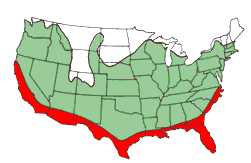Drywood Termites (Kalotermitidae)
-- More common in warm climates --
Summary: Drywood termites are important structural pests in tropical and warm/dry climates. Unlike most other termites, drywood termite colonies do not need direct contact with soil moisture. Termite colonies and damage can occur inside structural wood elements without evidence of external mud tunnels that are characteristic of other termites. Detection and control of "drywoods" can therefore be much more difficult.
Drywood termite identification
Unlike subterranean termites which built colonies in the soil, drywood termite colonies do not need contact with soil moisture nor any other water source. As their name suggests, drywood termites occur in dry wood that may be above ground level. Drywood termites build colonies in structural wood, fence and utility posts, furniture, moldings, door and window frames, and so forth. Because termite workers can be difficult to identify, species are often determined based on geographical location, location of colony and/or type of wood damage (see How Are Subterranean Termites Different?).
In the US drywood termites are found in regions that do not experience freezing temperatures during most winters (red areas of map). Isolated infestations may occasionally be found in cooler climates however. Drywood termites also may be transported in wooden articles and start local, indoor infestations in any climate zone.

How to detect drywood termite activity/damage
Since colonies are usually constructed inside wood, finding these termites can be difficult during routine pest and dry-rot inspections. Therefore, one of the best ways to identify an active infestation is the presence of their distinctive fecal pellets.
Drywood termite fecal pellets (aka frass or droppings) are kicked out of the colony by the worker termites and may accumulate in piles below infestations. Under magnification the fecal pellets are ridged, slightly pointed on both ends (egg-shaped) and about 1/25" long (about the size of table salt). Subterranean termites, on the other hand, do not kick out dry fecal pellets from their colonies and drywood termite fecal pellets are much larger than the boring dust particles of powderpost beetles.
What does drywood termite damage look like?
Wood is damaged as the worker termites tunnel to enlarge their colony. Drywood termite galleries cut across the wood's grain thus weakening the wood's internal structure and eventually the wood fails. Fecal pellets may be packed into some of the galleries
Drywood termite damage tends to progress more slowly than damage from subterranean termites but because it is so difficult to detect, considerable damage, extending over a wide area, may be present by the time it is first found.

Treatment and control of drywood termites
Drywood termite control is generally not a DIY project for most homeowners. Baiting, which is effective for some other termites, is not an option because drywood termites never leave the protection of their galleries. Perimeter sprays, that are effective for carpenter ants, won't work here either. And, treating the soil under and around the structure with a termiticide, which is used for subterranean termites, does not work because drywood termites may never contact the soil.
Limited control can be achieved by treating individual colonies as they are found during reconstruction or remodeling. These found colonies can be treated by drilling into the wood and injecting insecticides such as Bora Care, Termidor or Premise and/or several foam-type insecticides directly into the tunnels (see this page at DoMyOwn.com for more info) and Bora Care Insecticide and Termidor Insecticide.
Drywood termite infestations can be prevented by the use of pressure treated wood. Wood that has only been surface-treated with borate, copper-arsenate preservative, or paint will stop an initial attack, but new cracks or cuts must be retreated.
Finally, if an infestation is widespread it may be necessary to "tent and fumigate" the whole building. This is an expensive and difficult procedure and is definitely not a DIY project. You may need to hire pest control services to deal with an established infestation of drywood termites (see Fumigation for Structural Pests).

Supplies
Professional-level pest control supplies are generally not available in home and garden stores but can be found at DoMyOwn.com, our affiliate.

How to search 'Bugs for more information
The easiest way is to open a Google search page and type: "your query" + site:livingwithbugs.com into the search box. For example, to find all 'Bugs articles about carpenter ants type: carpenter ants + site:livingwithbugs.com in the search box.
The resulting list of pages may contain some Google advertising (marked with "Ad" next to the URL) as well relevant pages from 'Bugs. The ads do not originate with 'Bugs.
